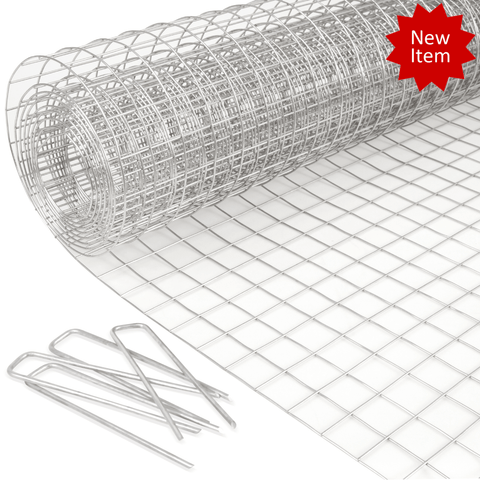Integrated Pest Management Strategies Using Gopher Netting: Protecting Your Garden's Bounty
Gardening is a deeply satisfying hobby, offering a sense of accomplishment and the joy of nurturing life. However, one persistent challenge that gardeners face is the presence of garden pests, such as gophers, that can wreak havoc on your carefully cultivated plants. Integrated Pest Management (IPM) is an eco-friendly and effective approach to pest control that seeks to minimize the use of harmful chemicals. In this blog, we'll explore the use of gopher netting as a vital component of IPM strategies to protect your garden's bounty.
Understanding Integrated Pest Management (IPM)
Integrated Pest Management is a holistic and sustainable approach to pest control that focuses on long-term solutions while minimizing the impact on the environment. IPM strategies prioritize prevention, monitoring, and the use of less harmful methods to manage pests. It encourages the use of biological controls, mechanical barriers, and cultural practices to maintain a healthy garden ecosystem.
The Gopher Problem
Gophers are notorious garden pests that can quickly turn your flourishing garden into a battlefield. These burrowing rodents tunnel underground, feeding on plant roots and causing extensive damage. To effectively address this issue while adhering to IPM principles, gopher netting is a valuable tool.
Gopher Netting: An IPM Essential
1. Prevention is Key: Gopher netting serves as a physical barrier that prevents gophers from accessing your garden beds. By installing netting before planting, you create a protective shield for your plants.
2. Environmentally Friendly: Gopher netting aligns perfectly with IPM principles by avoiding the use of chemical pesticides that can harm beneficial insects and the ecosystem.
3. Non-Lethal: Unlike traps or poisons, gopher netting is non-lethal. It keeps gophers out of your garden without causing harm to the creatures.
4. Durability: High-quality gopher netting is durable and long-lasting. It can be reused season after season, reducing waste and saving you money in the long run.
5. Easy Installation: Gopher netting is relatively simple to install. It can be laid out on the soil surface or buried a few inches below the ground to create a secure barrier.
Steps to Implement Gopher Netting in Your Garden
1. Assess Your Garden: Identify areas of your garden that are vulnerable to gopher activity. Focus on raised beds, vegetable gardens, and areas with newly planted seedlings.
2. Choose the Right Netting: Select gopher netting that is appropriate for your garden's needs. Ensure it is made from durable materials and is the correct size to cover your planting area.
3. Install Properly: If you're laying the netting on the surface, secure the edges with landscape staples. If burying, ensure it is at least 6 inches below the soil surface.
4. Regular Inspections: Periodically check the netting for any damage or signs of gopher activity. Repair or replace as needed.
5. Combine with Other IPM Practices: Gopher netting is most effective when used in conjunction with other IPM strategies such as crop rotation, companion planting, and maintaining a healthy soil ecosystem.
6. Grid System: Divide your garden into smaller sections or plots, each covered with gopher netting. This modular approach makes it easier to manage and replace netting if needed.

7. Raised Beds: Consider using raised beds with gopher netting lining the bottom. This not only provides protection from gophers but also improves drainage and soil quality.
8. Plant Selection: Opt for plants that are less attractive to gophers. While gophers may not have a strong aversion to certain plants, they tend to avoid plants like daffodils, fritillarias, and castor bean plants.
9. Natural Predators: Encourage natural predators of gophers, such as snakes, owls, and raptors, to inhabit your garden. Provide nesting boxes or habitat to attract these beneficial animals.
10. Vibrating Rodent Repellents: Invest in solar-powered vibrating rodent repellent devices. These emit vibrations that deter gophers from tunneling in the protected area.
11. Monitoring: Regularly inspect your garden for signs of gopher activity, such as mounds of soil or damaged plants. Early detection allows for quick intervention.
12. Bait Stations: If you have identified specific gopher tunnels, you can place bait stations in these areas. However, exercise caution and use this method sparingly to avoid harming non-target wildlife.

13. Companion Planting: Integrate gopher-resistant plants with your valuable crops. For example, planting marigolds, which gophers dislike, alongside your vegetables can provide some protection.
14. Garden Barriers: Use gopher netting in conjunction with other physical barriers like hardware cloth or wire mesh to create a comprehensive defense against gophers.
15. Mulching: Apply mulch around the base of your plants. While not a direct deterrent to gophers, mulch can make it more difficult for them to dig into the soil.
16. Regular Weeding: Keep your garden beds free of weeds, as gophers may use weed cover as a hiding place and a food source.
17. Community Effort: Coordinate with neighboring gardeners to implement gopher control measures collectively. Gophers don't respect property boundaries, so a collaborative approach can be more effective.
18. Education: Educate yourself and your gardening community about gopher behavior and IPM practices. Sharing knowledge and experiences can lead to better pest management.
19. DIY Gopher Baskets: Craft gopher-proof wire mesh baskets to protect the roots of individual plants. Plant your seedlings or bulbs inside these baskets to deter gopher damage.
20. Native Plant Selection: Consider incorporating native plants into your garden design. These often have natural defenses against local pests, including gophers.
Remember that an effective IPM strategy often involves a combination of methods, as no single approach is foolproof. By incorporating gopher netting into your pest management plan and tailoring it to your garden's specific needs, you can enjoy a thriving garden while minimizing the impact of gophers and other pests. Happy gardening and successful pest management!
